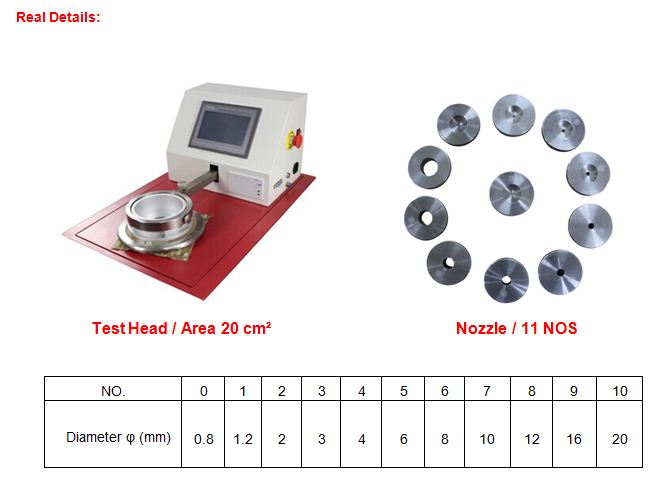Description
Summary:
Air permeability is an important factor in the performance of such textile materials as gas filters, fabrics for air bags, clothing, mosquito netting, parachutes, sails, tentage, and vacuum cleaners. In filtration, for example, efficiency is directly related to air permeability. Air permeability also can be used to provide an indication of the breathability of weather-resistant and rainproof fabrics, or of coated fabric in general, and
to detect changes during the manufacturing process. In specialty, industrial and military applications, it can play a vital role in protection. In every market, satisfying the demands of consumers and producers requires ways to accurately and repeatably test material air flow.
Usage:
To determine the resistance of fabrics (woven, knitted and non-woven textile materials) to the passage of
air (air flow) under constant pre-set air pressure while firmly clamped in the test rig of selected test head/area.
Standard:
ASTM D737 Standard Test Method for Air Permeability of Textile Fabrics
ISO 9237 Textiles – Determination of the Permeability of Fabrics to Air
BS 5636, DIN 53887, AFNOR G07-111, EDANA 140.1, ISO 7231, ISO 9073-15, JIS L1096-A
TAPPI T251, WSP 070.1.R3, EDANA 140.2-99
Features:
- Wide measuring range of 0.1-12,000 l/m²/s at 20 cm² test area.
- Wide test pressure range of 1-4,000 Pa.
- For filter media: Determination of the pressure drop at a given air velocity.
- Automatic control of the test pressure.
- Fast and simple sample clamping(Pneumatic Clamping Assembly).
- Touch control panel for digital display of the test result.
- Quiet and mobile instrument, perfectly suitable for use in the laboratory and in the production area.
- Data ports: RS 232. Ethernet for direct network access.
- Integrated software for evaluation and storage of the test results in office format.
- Can be connected to a PC with the Evaluation Program SBT461 Air Permeability Tester lab-cloud.
- Works in accordance with all major test standards.
Specifications:
| Measuring range | 0.1-12,000 mm/s at 20 cm² test area. |
| Units of measure | mm/s, ft³/ft²/min, cm³/cm²/s, l/m²/s, l/dm²/min, m³/m²/min, m³/m²/h, dm³/s
Pa (pressure drop) |
| Measuring accuracy | better than ± 2 % of the displayed value. |
| Test pressure | 1-4,000 Pa |
| Test areas | 5, 20, 25, 38.5, 50, 100 cm² |
| Sample thickness | < 12mm |
| Dimensions | 1070 x 670 x 1080 mm |
| Power supply | 220V, 50Hz or 110V, 60Hz |
| Weight | 75kg |
Test Procedure:
1.Test the conditioned specimens in the standard atmosphere for testing textiles, which is 21 ± 1°C (70 ± 2°F) and 65 ± 2 % relative humidity, unless otherwise specified in a material specification or contract order.
- Handle the test specimens carefully to avoid altering the natural state of the material.
- Place each test specimen onto the test head of the test instrument, and perform the test as specified in the manufacturer’s operating instructions.
- Place coated test specimens with the coated side down (towards low pressure side) to minimize edge leakage.
- Make tests at the water pressure differential specified in a material specification or contract order. In the absence of a material specification or contract order, use a water pressure differential of 125 Pa (12.7 mm or 0.5 in. of water).
6.Read and record the individual test results in SI units as cm³/s/cm² and in inch-pound units as ft³/min/ft² rounded to three significant digits.














Reviews
There are no reviews yet.